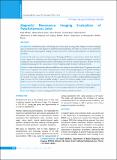Please use this identifier to cite or link to this item:
https://hdl.handle.net/20.500.14356/1070Full metadata record
| DC Field | Value | Language |
|---|---|---|
| dc.contributor.author | Adhikari, Kapil | - |
| dc.contributor.author | Gupta, Mukesh Kumar | - |
| dc.contributor.author | Devkota, Karun | - |
| dc.contributor.author | Baral, Pramod | - |
| dc.contributor.author | Koirala, Sapana | - |
| dc.date.accessioned | 2023-04-21T09:09:40Z | - |
| dc.date.available | 2023-04-21T09:09:40Z | - |
| dc.date.issued | 2021 | - |
| dc.identifier.citation | AdhikariK., Kumar GuptaM., DevkotaK., BaralP., & KoiralaS. (2021). Magnetic Resonance Imaging Evaluation of Patellofemoral Joint. Journal of Nepal Health Research Council, 19(1), 122-126. https://doi.org/10.33314/jnhrc.v19i1.3063 | en_US |
| dc.identifier.issn | Print ISSN: 1727-5482; Online ISSN: 1999-6217 | - |
| dc.identifier.uri | http://103.69.126.140:8080/handle/20.500.14356/1070 | - |
| dc.description | Original Article | en_US |
| dc.description.abstract | Abstract Background: Patellofemoral pain is the leading cause of knee pain in young adults. Magnetic resonance imaging plays an important role in early diagnosis of patellofemoral joint pathology. This study was carried out to evaluate the patellofemoral joint using magnetic imaging resonance and describe various predisposing factors for patellofemoral instability. Methods: The study was carried in Department of Radiology, BPKIHS over a period of six months from February 2020 to August 2020. All patients with clinical diagnosis of patellar instability were included and Magnetic resonance imaging was done using standard knee protocol and findings were noted on structured proforma. Analysis was done using statistical package for the social sciences version 20 applying simple descriptive statistical methods. Results: A total of 60 patients who underwent MRI knee were analyzed, out of which 28(46.7%) patients were male while 32(53.3%) patients were female. 44 patients (58.3%) had various predisposing factors for patellar instability. The commonest predisposing factor was patellar subluxation (73.3%) followed by abnormal trochlear groove angle (58.3%) and patellar translation (increased tibia tubercle trochlear groove distance) (53.3%). Various MRI findings in our study were bone contusion (28 cases,46.7%), joint effusion (36 cases,60%), medial patellofemoral ligament injury (11cases ,18.3%), erosion of patellar cartilage (5 cases,8.3%), femoral cartilage erosion (3 cases,5%),loose bodies (2 cases,3.3%), subchondral edema (3 cases,5%) and meniscus injury (18 cases,30%). Conclusions: Magnetic resonance imaging is not only useful in assessing lesions of the bone, cartilage and ligaments of patellofemoral joint but also enables detection of various predisposing factors for patellofemoral instability. Keywords: Magnetic resonance imaging; patellofemoral instability; patellofemoral joint | en_US |
| dc.language.iso | en | en_US |
| dc.publisher | Nepal Health Research Council | en_US |
| dc.relation.ispartofseries | Jan-March, 2021;3063 | - |
| dc.subject | Magnetic resonance imaging | en_US |
| dc.subject | patellofemoral instability | en_US |
| dc.subject | patellofemoral joint | en_US |
| dc.title | Magnetic Resonance Imaging Evaluation of Patellofemoral Joint | en_US |
| dc.type | Journal Article | en_US |
| local.journal.category | Original Article | - |
| Appears in Collections: | Vol. 19 No. 1 (2021): Vol. 19 No. 1 Issue 50 Jan-Mar 2021 | |
Files in This Item:
| File | Description | Size | Format | |
|---|---|---|---|---|
| 3063-Manuscript-21584-1-10-20210425.pdf | Fulltext Download | 551.52 kB | Adobe PDF |  View/Open |
Items in DSpace are protected by copyright, with all rights reserved, unless otherwise indicated.
